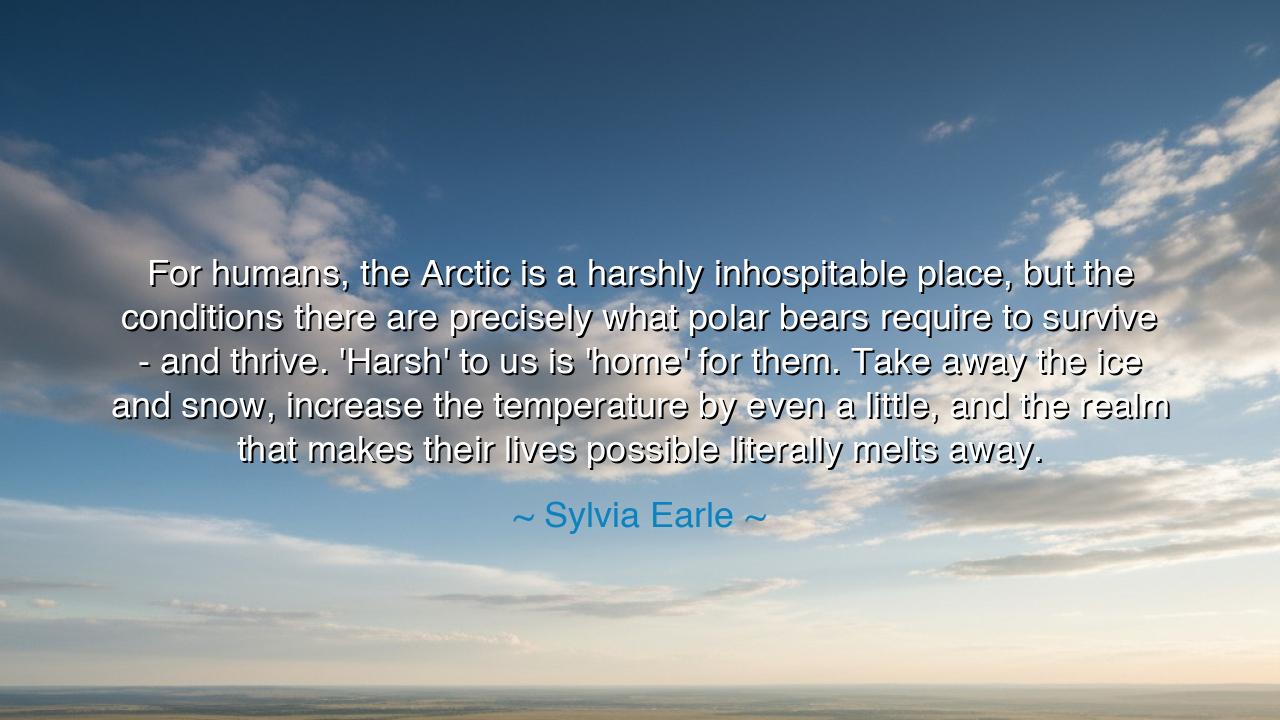
For humans, the Arctic is a harshly inhospitable place, but the
For humans, the Arctic is a harshly inhospitable place, but the conditions there are precisely what polar bears require to survive - and thrive. 'Harsh' to us is 'home' for them. Take away the ice and snow, increase the temperature by even a little, and the realm that makes their lives possible literally melts away.






In the sea-bright witness of Sylvia Earle—“For humans, the Arctic is a harshly inhospitable place, but the conditions there are precisely what polar bears require to survive—and thrive… ‘Harsh’ to us is ‘home’ for them… Take away the ice and snow, increase the temperature by even a little, and the realm that makes their lives possible literally melts away”—we hear an old law spoken with modern urgency: the world is not arranged around our comfort. What chills our breath is the very warmth of another creature’s belonging. We name a landscape harsh, and in the same breath a species calls it home. Thus the sentence turns our gaze from appetite to stewardship, from conquest to reverence.
The elders would say each being carries a covenant with its place. The polar bears, crowned with frost and patience, read the ice as book and table: leads for hunting, floes for travel, dens stitched into wind-carved drifts. Where we measure misery, they measure opportunity; where we see blankness, they see a map. Earle’s wisdom cuts clean—change the temperature even a little and the covenant is broken. The realm that holds their story melts away, not in metaphor but in fact, and with it vanishes a grammar of life written over millennia.
Consider a true tale from the white edge of the world. In Svalbard, scientists once tracked a mother bear and her cub across a lattice of spring ice. The floes came late and parted early; the swim between them lengthened beyond safety. The collar told the rest: detours, pauses, desperate crossings. What had been a road became a riddle, then a wall. “Only a little warmer,” the charts said. But “a little” is a king’s ransom when a body is tuned to snow, when fat is currency, when distance steals heat. The cub did not see a policy debate; it saw water where the world had promised bridge.
History carries a second witness: the voyages of Fridtjof Nansen and the Fram, drifting with the pack to learn its pulse. Nansen learned from the Inuit that survival there is not the taming of the Arctic, but its partnership—how seal-breath fog marks a breathing hole; how snow speaks direction; how patience outruns strength. He proved what Earle teaches: the so-called harsh is a web of precise mercies. Change the weave, even slightly, and the web cannot hold its weavers.
Mark the deeper meaning: calling a place harsh reveals our limits, not the land’s failure. Home is not universal; it is patterned. The musk ox has one pattern, the auk another, the polar bears a third. When our furnaces and engines lift the temperature, we do not merely warm ourselves; we redraw other beings’ patterns without their consent. This is the hubris the proverb warns: to act as if our comfort were the axis, as if the realm existed to entertain us rather than to be tended.
From this, let the lesson be carved like runes into cold stone: cherish what is necessary to another’s home, especially when it is not necessary to yours. The measure of a wise people is not how perfectly they furnish their own rooms, but how faithfully they protect the rooms of others—the high ice, the desert dusk, the river’s bend, the forest shade. Stewardship is love practiced at planetary scale.
And let the counsel be practical, as befits a teaching meant to endure. (1) Press for swift cuts to emissions that heat the air and melt away the sea ice—vote, invest, and labor for clean power and efficient cities. (2) Defend large, connected marine and terrestrial sanctuaries in the Arctic, where the realm can breathe—no new drilling in nurseries, strict rules for shipping lanes and noise. (3) Honor Indigenous knowledge—co-manage wildlife corridors, listen to hunters who read snow and sky as text. (4) Shrink the daily burn: fly less when you can, warm less when you can, waste less because you can. (5) Teach the young that “harsh to us is home for them,” so that awe, not pity, shapes their care.
At last, remember the cadence beneath Earle’s words: we live among specialized miracles. The polar bears are one bright stanza in a longer hymn; the Arctic is their instrument. If we detune it by “even a little,” their music ceases—and the choir of Earth is poorer, and so are we. Guard, then, the ice and snow with the gravity one gives to a neighbor’s hearth. For in guarding their home, you prove yourself worthy of your own.






AAdministratorAdministrator
Welcome, honored guests. Please leave a comment, we will respond soon